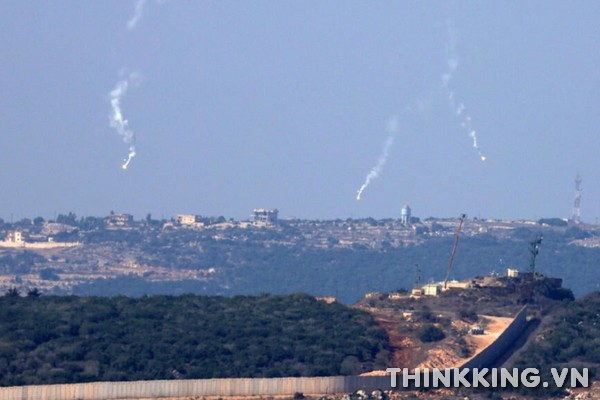Beyond the Battlefield: The Fight for Historical Perception
In the quiet stillness of a Gaza night, a game of high-stakes psychological chess unfolds, far from the prying lenses of global media. Here, the battlefield extends beyond the tangible into the cerebral corridors of the enemy’s psyche. This is a tale of the IDF’s covert warriors and their clandestine dance with Hamas, a narrative that charts the manipulation of perception and the subtle crafting of public sentiment. In this intricate theater of war, fuel becomes more than a mere commodity—it transforms into a weapon of influence, a testament to Israel’s strategic prowess in the psychological domain.
I. The Silent Soldiers of Psyche

In the shadowy realm of conflict, where the clash of arms echoes, there exists an equally intense battleground that remains unseen—the human mind. Psychological warfare, an ancient stratagem, has evolved into a sophisticated tool in modern warfare, wielded by silent soldiers skilled in the art of influence. These architects of thought work clandestinely, their names unknown, their presence felt only through the ripples of their actions.
Psychological warfare operates on the principle of using non-lethal force to achieve military objectives. It targets the enemy’s will to fight, aiming to demoralize and disrupt through misinformation, propaganda, and psychological tactics. It’s a game of minds where perception is reality, and the manipulation of perception is the ultimate power.
The secret soldiers behind these operations are a diverse cadre of experts, ranging from intelligence analysts to behavioral psychologists, from information technology specialists to cultural advisors. They are the modern-day mages who conjure illusions, craft messages, and disseminate information—or disinformation—with the intent to confuse, degrade, and demoralize the adversary.
These specialists harness a deep understanding of human behavior, cultural nuances, and the psychological underpinnings that drive group and individual actions. With this knowledge, they craft campaigns that can sow seeds of doubt, weaken resolve, or even convince the enemy of an alternate reality. Their tools are not rifles or drones, but the very thoughts and beliefs that define their targets’ actions.
As warfare continues to evolve, the importance of these silent soldiers grows. In an age where information can be as impactful as a physical strike, psychological operations have become a critical component of military strategy, with the power to shape the course of conflicts from behind the scenes.
II. The Fuel Gambit: A Case Study
In the strategic theater of the Gaza Strip, a curious operation unfurled near the Al-Shifa Hospital—traditionally a sanctuary in the chaos of conflict. Under the cover of darkness, IDF forces executed a maneuver of an unusual kind, delivering jerry cans filled with diesel fuel just outside the medical facility’s reach. This act was not a straightforward supply mission; it was a move in a complex game of psychological chess.
The operation’s success was not measured by the transfer of fuel but by the influence it exerted on public perception. By placing the fuel and retreating, the IDF set a stage where every outcome was a calculated message to the international community. If Hamas accepted the fuel, Israel’s narrative would be one of providing humanitarian aid despite hostilities. If rejected, it would underscore Hamas’s apparent disregard for the well-being of Gazan civilians, particularly the sick and vulnerable who relied on the hospital.
This gambit played out in the domain of global opinion, where cameras and headlines often dictate the victor. It was a power move designed to portray the IDF as a conscientious actor within the conflict, juxtaposing this against the image of an adversary indifferent to civilian needs. The strategy extended beyond the immediate tactical advantage, aiming to cement a specific narrative in the international psyche.
The strategic implications were profound. In the eyes of the world, the operation painted a picture of complexity and contradiction, challenging the black-and-white portrayal of aggressor and victim. It leveraged the inherent power of imagery and narrative, demonstrating that in modern warfare, the control of public perception can be as significant as territorial gains. The fuel gambit was a case study in the subtle art of psychological influence—where the real target was minds, not matter.
III. A Symphony of Covert Tactics

In the nuanced world of psychological operations (psyops), the tools of persuasion are categorized by the color-coded stratagems of white, grey, and black operations, each denoting the level of attribution and truthfulness to the source. White psyops are overt operations where the information is truthful and the source is clearly identified. These are the public relations campaigns of the psychological battlefield, often involving leaflets, broadcasts, and press releases that aim to build credibility and rapport with the audience.
Grey psyops occupy the middle ground, where the truth may be mingled with ambiguity or selective presentation. The source is not clearly labeled, allowing the orchestrating party plausible deniability. Grey operations are the subliminal messages in the symphony of covert tactics, more subtle and insidious, designed to raise doubts and influence perceptions without clear fingerprints.
Black psyops, the most covert of the three, involve the dissemination of falsified information or deceptions, with the source completely hidden or attributed to another party. These operations are the dark arts of psychological warfare, where the intent is to deceive, disrupt, and demoralize.
Creativity in crafting psychological campaigns is paramount; it’s an art form that combines deep psychological insights with innovative communication strategies. These silent soldiers must understand the fears, hopes, and cultural nuances of their target audience, tailoring messages that resonate and achieve the desired psychological effect. They must anticipate responses and plan several moves ahead, much like a grandmaster in chess.
Whether it’s designing an elaborate hoax to mislead enemy intelligence, developing a soap opera that subtly delivers a persuasive narrative, or crafting the perfect soundbite for a viral social media post, creativity is the lifeblood of effective psychological operations. It is through these creative endeavors that psychological campaigns can achieve strategic goals, often without a shot being fired.
IV. The Ripple Effects
Impacts on Gazan Civilians
The psychological impact of operations like the fuel gambit on Gazan civilians can be profound and multifaceted. On one hand, such operations may create a sense of uncertainty and confusion. Civilians, already in the throes of conflict, may find it challenging to discern the intentions behind the provision of aid when coupled with the backdrop of military action. This can lead to a stressful paradox where the line between friend and foe is blurred, exacerbating the psychological toll of the conflict.
On the other hand, these psyops can also have an unintended galvanizing effect on the local population. If perceived as manipulative or deceitful, they can foster a sense of solidarity against what is seen as an external attempt to influence or control. This can result in strengthening community bonds and resolve, rather than weakening them.
International Repercussions
Globally, the response to psyops strategies can be equally complex. Advanced psyops like the fuel gambit can sometimes backfire if the intended message is not received as planned or if the operation is uncovered and publicized as a manipulation. This can lead to international condemnation and a loss of credibility, which can be particularly damaging in the information age where global opinion is shaped in real-time on social media platforms.
Conversely, when executed effectively, such operations can shift international narratives and influence diplomatic relationships. By framing one’s actions in the context of humanitarian assistance or self-defense, a state can garner sympathy and support from the international community. This can lead to increased diplomatic leverage, economic aid, or bolstered international partnerships.
In both the local and international arenas, the ripple effects of psyops strategies underscore the critical importance of understanding the psychological landscape. The reactions they provoke can be unpredictable and can sometimes have lasting impacts on both the local populace and international opinion, long after the immediate conflict has subsided.
V. Ethics in the Shadows
The Boundaries of Warfare
Operatives engaged in the shadows of psychological warfare grapple with moral dilemmas that are often not as clear-cut as those faced in traditional combat. Psyops, by their very nature, involve manipulation of information and can tread a fine line between influence and deception. The moral quandaries arise from questions such as:
-
Truth vs. Deception: When, if ever, is it justified to use deception as a tool? While white psyops involve truthful information, grey and black operations can involve misleading information or outright lies. The ethical implications of such tactics weigh heavily on the scale of just war theory.
-
Collateral Psychological Damage: What are the consequences of these operations on the civilian population’s mental health and societal trust? Psychological operations can induce stress, fear, and confusion among civilians, which raises the question of the ethical responsibility of the operatives towards non-combatants.
-
Long-Term Consequences: How do the immediate benefits of a psyop weigh against potential long-term harm to the social fabric or international relations? The erosion of trust in public institutions or the fostering of a culture of paranoia can have lasting impacts.
Countering Disinformation
Disproving enemy propaganda, especially in the age of rapid information dissemination, is a daunting task. Propaganda is designed to be emotionally charged and to exploit biases, making rational counterarguments less effective. The challenges include:
-
Speed and Scale: Disinformation can spread far and wide before factual counterarguments get a foothold. The adage “A lie can travel halfway around the world before the truth can get its boots on” is especially relevant in the digital age.
-
Cognitive Biases: Humans are prone to cognitive biases such as confirmation bias, where they favor information that confirms their preexisting beliefs. This makes countering disinformation with facts alone a complex task.
-
Information Overload: The sheer volume of information available makes it difficult for factual corrections to stand out and for audiences to discern what is true.
-
Trust Deficit: A general distrust in authorities or official sources can hinder efforts to counter disinformation. If the public does not trust the source of the counter-narrative, they may dismiss it regardless of its factual accuracy.
The struggle against disinformation requires a multifaceted approach, combining rapid response, transparent communication, media literacy education, and perhaps most importantly, the building and maintaining of public trust. This is a battle not just for the minds, but for the hearts of the populace, where credibility is the currency of victory.
VI. The Aftermath and the ‘Day After’
Narrative Control Post-Conflict
In the aftermath of conflict, controlling the narrative becomes crucial in shaping how the conflict is remembered and understood. The concluding narratives of war can influence everything from political outcomes and historical records to the collective memory and identity of societies. Key considerations include:
-
Crafting the Victory Story: The victors often have the power to shape the post-conflict narrative. This story can frame the conflict in terms of good versus evil, just versus unjust, or necessary versus avoidable, affecting future policy and public sentiment.
-
Accountability and Truth-Telling: Truth and reconciliation processes attempt to establish a shared understanding of the conflict’s events, aiming to address grievances and prevent the recurrence of violence. The balance between seeking justice and fostering societal healing is delicate.
-
Memory and Commemoration: How a conflict is commemorated through memorials, anniversaries, and education can perpetuate certain narratives while marginalizing others, impacting the collective memory of a society.
Reconstructing Reality
The aftermath of conflict and the narratives that emerge from it have a profound influence on future perceptions and can shape realities for years to come:
-
Historical Precedents: The way a conflict is recorded in history sets a precedent for future actions and interpretations of international law and norms. It becomes a reference point for what is considered acceptable conduct in warfare.
-
Societal Beliefs and Attitudes: The aftermath narrative can influence the beliefs and attitudes of a society towards other nations, cultures, or ideologies, potentially sowing the seeds for future conflict or, conversely, fostering a culture of peace and understanding.
-
Policy and Diplomacy: The dominant narrative post-conflict can impact foreign and domestic policy decisions. It can also influence the approach to diplomacy, including peace treaties, reparations, and ongoing relations between former adversaries.
Narrative control in the post-conflict phase is about more than just setting the record straight. It’s about shaping the identity of nations and the international community, influencing future generations, and determining the path forward from the ruinous paths of war. The narratives that emerge can either divide or heal, inflame tensions or encourage forgiveness, and they can set the stage for either perpetual conflict or lasting peace.
Closing Paragraph: As the dust settles on the battle-scarred streets of Gaza, the true extent of psychological warfare’s potency comes to light. It’s a realm where fuel can ignite a firestorm of debate, where silent soldiers wield influence with the deftness of a maestro, and where the victor is often the one who best narrates the story. This is the art of war in its most cerebral form, where every move is a calculated stroke in the grand canvas of human consciousness.
Frequently Asked Questions (FAQ):
-
What is psychological warfare? Psychological warfare involves using propaganda, misinformation, and other psychological operations to influence the perceptions and behaviors of adversaries, allies, and neutral parties during conflicts and in the broader strategic context.
-
How does psychological warfare impact civilians? It can lead to confusion, fear, disinformation, and sometimes even manipulation of civilian populations, potentially affecting their attitudes and behaviors during and after conflict.
-
What are the ethical considerations of psychological warfare? Ethical considerations include the potential harm to non-combatants, the use of deception and manipulation, and the long-term psychological impacts on both the target population and the operatives themselves.
-
Can psychological warfare determine the outcome of conflicts? While not solely decisive, psychological warfare can significantly influence the morale, decision-making, and public perception, which can contribute to the outcome of conflicts.
-
How do nations counteract psychological warfare from adversaries? Nations employ counter-propaganda, strengthen their cybersecurity, educate their populace on media literacy, and maintain transparency to build resilience against psychological warfare.










